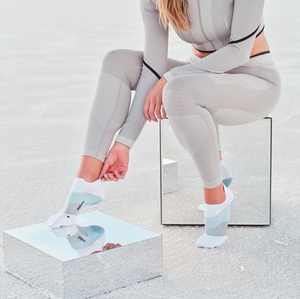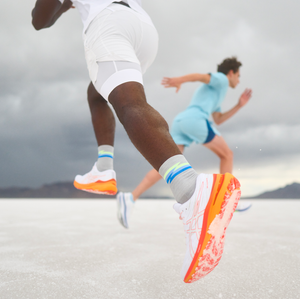A Quick Background:
What is Socks and Hops?
Socks and Hops is an annual event in Kansas City hosted by Swope Health to raise awareness for their Homeless program as well as their Mobile Medical Unit. The event has collected more than 4,000 socks for homeless patients. Socks are among the most-requested items at homeless shelters. Socks provide warmth and protection, and in the cold, can help prevent frostbite.
At Socks and Hops, local craft breweries and chefs come together to provide a “one of a kind evening full of tastes, sips, and community!”
What is Plantar Fasciitis?
Plantar fasciitis is an inflammation of a thick band of tissue that connects the heel bone to the toes that is one of the most common causes of heel pain. Activities that place a lot of stress on your heel and attached tissue, such as long-distance running, can contribute to the onset of plantar fasciitis.
The Story
As I eased into the back row of the rental van, my eyebrows furrowed and nose scrunched. Downturned lips involuntarily bit my shirt collar.
“I know. It smells like the weekend my wife and I went away and the cat got trapped in the dryer,” the van’s driver said. “We’ll all get out and stretch and air out in a second.”
“It’s not that,” I shifted like a child who can’t quite communicate what he needs. “It’s just that...that last mile it felt like someone sliced open the bottom of my foot with a X-Acto knife and started scooping, um, foot tissue out like it was Gelato.”
The music paused and everyone on my Ragnar Wasatch Back team turned to me at once and said in a sweaty Greek chorus: Plantar fasciitis!
...And then they turned back around. Katy Perry started to roar once more from the cracked speakers as watches were synchronized and topo maps shuffled.
A last-minute add, I was running my first relay as a member of Team Suunto. It was a regrettable inaugural effort. A self-proclaimed “hill specialist”, I’d just plodded up the climb-to-Snowbasin leg as “if I was wearing snowshoes” said the van’s driver—who also happened to be the team organizer. The group estimated we’d have to push the pace and make up a minute a mile to catch the lead teams by morning in the wake of my labored performance.
My van mates were a mix of hard-charging employees of the Finnish time piece’s Ogden-based US HQ as well as a few of Suunto’s local endurance athletes. Anything less than Prefontaine mounted atop Pegasus for my cartilage-crushing four-mile all-singletrack downhill at Deer Valley would leave me hitchhiking the rest of the way to the finish—not that leaving the van sooner than later was necessarily a bad thing.
I had precisely three hours to get my mind and feet right. So, I did what any desperado does: I tried to google my way out of it.
That’s when I found out Plantar fasciitis is caused by everything I was doing during that particular race: A sudden uptick in mileage, stress on the feet or lack of stretching (especially the calves) prior to a run and wearing old or ill-fitting running shoes and their tired, saggy sock counterparts.
The plantar fascia itself is made of stretched-like-taffy protein which connects the heel bone to the toes and makes up the arch of the foot. The tissue can inflame or rip causing that Jason-is-stabbing-me-like-I’m-a-teenager-trapped-in-a-cabin feeling I was experiencing at 9,000 feet.
Though this sensation is something all 46 million runners worldwide have had at one point or another, most don’t enjoy the luxury of having to find a cure in-race. I needed something to stop the deranged killer with mommy issues in a hockey mask hacking up my arches post-haste. In other words, I needed a miracle.
A quick scan of my options: Roll arch over golf or tennis ball every night for 45 minutes; run on soft, flat surfaces or reduce mileage by 10 percent per week; institute heavy-and-regimented stretching and warm-up/warm-down routine before/after runs; absolutely NO walking around in flip flops or barefoot until pain subsides; change out shoe/sock kit and get fit with custom orthotics; PT or even shock-wave therapy. All great solutions. All helping me zilch as the clock continued to count down to my leg.
Dawn soon crested over the Wasatch and after watching my teammates sweat and (literally) bleed their way up to the crest of Deer Valley, the van grew quiet with nerves and expectation. My butterflies overtook the stretched-beyond-burning sensation radiating from the unraveling tightrope which connected my heels and toes.
The van driver’s eyes caught mine in the rear view as he put it in park. I got out and looked at him while I fake stretched, white with panic.
“Feet still hurt?”
“No. Not anymore I think,” I tried to downplay unconvincingly.
He led me to the back of the van and opened the double doors. He pushed aside a cooler top and popped open a Porter. He handed me three Advil. “Here,” he said. “I need you to finish this in the next minute. Take off your shoes and socks.”
He balled up my crusty socks and tossed them into the brush. He examined my shoes and took out the factory-issue footbeds run to transparent. He reached into a giant duffle full of schwag and ripped the cardboard sheaths from my first pair of running insoles and Feetures socks and sleeves.
The beer/Ibuprofin cocktail started to take hold and, with the new cushion and support, my feet suddenly went from being James Bond hanging from the rafters in chains to James Bond on Egyptian cotton sheets with a glass of Champagne. A few generous belches later and I was ready to throw down. My goal time: Four downhill miles in under 21 minutes was all the van driver asked of me.
I finished in just over 24.
...Then I spent the next year paying my feet back with the proper insoles, shoes and socks along with a new daily stretching and balance routine. The killer from Camp Crystal Lake hasn’t come back for a single sequel. But just in case he does, I always carry the proper foot emergency supply kit in my race bag.
And the beer?
“A dark brew is key,” the van driver told me after the race. “It tastes so good and calms the nerves. Besides, we only needed you to break 26 and I wanted you to enjoy the run.”



Leave a comment